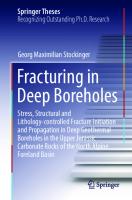Acoustic Waves in Boreholes (Telford Press S) 9780849388903, 0849388902
Introducing the first, self-contained reference on acoustic waveform logging Acoustic measurements in boreholes were fi
126 34 13MB
English Pages 280 [282]
Table of contents :
Cover
Title Page
Copyright Page
Preface
Dedication
The Authors
Acknowledgments
Table of Contents
1 Acoustic Measurement in Boreholes
1.1 General Comments on Acoustic Logging and Waveform Log Interpretation
1.2 Seismic Properties of Rocks and Their Characterization
1.3 Laboratory Measurement of Seismic Velocity and Attenuation
1.4 Geometric Effects and Scale of Investigation
2 Acoustic Well Logs and Porosity Logging
2.1 Acoustic Porosity Logging Equipment
2.2 Acoustic Transit Times and Porosity Logging
2.3 Receiver Geometry and Source Characteristics of Porosity Logging Equipment
2.4 Practical Considerations in Acoustic Transit Time Logging
2.5 Theoretical Predictions of Acoustic Velocities in Porous Solids
3 Principals of Seismic Refraction Along Boreholes and Channels
3.1 Modeling Wave Propagation in Channels and Boreholes
3.2 Refraction and Reflection at a Plane Interface
3.2.1 Critical Angle of Refraction and Complete Reflection of Acoustic Energy
3.2.2 Interface Waves Generated by a Point Source
3.3 Critical Refraction and the Generation of Head Waves
3.4 Acoustic Propagation in the Fluid-Filled Channel Waveguide
3.4.1 The Primary Role of Geometry—Constructive Interface and Trapped Modes
3.4.2 The Plane Channel Analog to the Fluid Filled Borehole
3.4.3 Fully Trapped Symmetric Modes and Head Waves
3.4.4 Critically Refracted Head Waves and First Arrivals
3.4.5 Guided Modes and Head Waves
3.4.6 The Missing Rayleigh Mode
3.5 Mode Summary
3.6 Mode Content, Channel Width, and Frequency Scaling
Appendix 3.1 Complex Contour Integration Evaluation of Wavenumber Transform for Synthetic Microseismograms
4 Synthetic Microseismograms in Fluid-Filled Boreholes
4.1 Synthetic Microseismograms—Modeling Borehole, Fluid, and Logging Tool
4.2 Boundary Conditions and Derivation of the Period Equations for Trapped Modes
4.3 Properties of the Pseudo-Rayleigh and Tube Wave Modes
4.4 Borehole Forcing and Source Specification
4.5 Synthetic Microseismogram Calculations
4.6 An Example of Waveform Computation
4.7 Mode Attenuation and Partition Coefficients
4.8 Synthetic Microseismograms for Nonsymmetric Modes
4.9 Symmetric and Nonsymmetric Modes in Transversally Isotropic Solids
Appendix 4.1 Boundary Condition Matrix Elements for Borehole Forcing With Axisymmetric Pressure sources
Appendix 4.2 Boundary Condition Matrix Elements for Borehole Forcing With Nonaxisymmetric Pressure sources
Appendix 4.3 Boundary Condition Matrix Elements for Borehole Forcing With Axisymmetric and Nonaxisymmetric Pressure Sources in Transversely Isotropic Formations
5 Synthetic Borehole Microseismograms, Rock Properties, and Waveform Log Interpretation in the Open Hole
5.1 The Natural Range of Seismic Velocities in Rocks
5.2 Effects of Borehole Diameter and Mode Content on Synthetic Microseismograms
5.3 Synthetic Microseismograms in Hard Formations— Effects of Lithography
5.4 Synthetic Microseismograms in Soft Formations
5.5 Comparison of Synthetic Microseismograms for the Natural Range of Lithologies
5.6 Comparison of Synthetic Microseismograms with Borehole Waveforms
6 Acoustic Log Interpretation Methods in the Open Hole
6.1 Frequency Response in Boreholes: Mode Content and First Arrivals
6.2 Picking Compressional Velocity: Examples with Synthetic Microseismograms
6.2.1 Velocity Picks in Two Formations Using Synthetic Examples
6.2.2 Depth of Penetration, Borehole Wall Alteration, and Long-Spaced Sonic Measurements
6.3 Picking Shear Wave Velocity
6.3.1 Shear Velocity from Waveforms (“Visual” Picks); Example From a Fast Formation
6.3.2 Semblance Cross-Correlation and Other Advanced Shear Picking Methods
6.3.3 Mode Content and Shear Wave Picking
6.3.4 Shear Logging with Shear Sources
6.4 Shear Velocities from Guided Waves in Slow Formations
6.4.1 Tube (Stonely) Wave Interpretation
6.4.2 Leaky P Mode Interpretation
6.5 Attenuation Measurements in Boreholes
6.5.1 Attenuation Using Waveform Amplitudes
6.5.2 Attenuation from Partition Coefficients
6.5.3 Attenuation Using Full Waveform Inversion of P Wavetrain
7 Synthetic Seismograms and Acoiustic Logging in Cased Boreholes
7.1 Formulating the Problem With Concentric Layers of Steel and Cement
7.2 Synthetic Microseismograms for Well Bonded and Poorly-Bonded Examples
7.2.1 Well-Bonded Cases
7.2.2 Poor Steel-Cement Bond, Good Cement-Formation Bond (Free Pipe)
7.2.3 Good Steel-Cement Bond, Poor Cement-Formation Bond (Unbonded Casing)
7.3 Velocity Picking in Cased Holes—Examples Using Synthetic Microseismograms
7.3.1 Maximum Likelihood Method (MLM)
7.3.2 Semblance
7.3.3 Open-Hole and Well Bonded Case
7.3.4 Free Pipe
7.3.5 Unbonded Casing
7.4 Velocity Picking in Casing Holes—Field Examples
7.4.1 Well-bonded case
7.4.2 Poor bonded case
7.5 Attenuation Measurements in Cased Boreholes
7.5.1 Partition Coefficients
7.5.2 Synthetic Example
Appendix 7.1 Elements of the D Matrix
Appendix 7.2 Boundary Conditions for Poorly Bonded Cased Holes
8 Acoustic Waveforms in Porous and Permeable Formations
8.1 Properties of Porous and Permeable Rocks
8.2 Wave Propagation in Permeable Solids—the Biot Model
8.3 Microseismograms in Permeable Formations
8.4 Effects of Pore Properties on Microseismograms in Porous Formations
8.5 Microseismograms for Nonsymmetric Modes in Porous Formations
8.6 Interpretation of in Stu Permeability in Porous Formations
Appendix 8.1 Boundary Condition Matrix for Axisymmetric Modes in a Fluid-Filled Borehole in a Porous Solid
Appendix 8.2 Boundary Condition Matrix for Nonaxisymmetric Modes in a Fluid-Filled Borehole in a Porous Solid
9 Qualitative and Quantitative Interpretation of Fracture Permeability by Means of Acoustic Full Waveform Logs
9.1 Waveform Logs in Fractured Rocks
9.2 Direct Correlation Between Tube Wave Attenuation and Fracture Permeability
9.3 Tube Wave Interpretation Models
9.4 Field Studies—Evaluation of Tube Wave Attenuation Models and Comparison with Other Estimates of Fracture Permeablity
References
Index
Cover
Title Page
Copyright Page
Preface
Dedication
The Authors
Acknowledgments
Table of Contents
1 Acoustic Measurement in Boreholes
1.1 General Comments on Acoustic Logging and Waveform Log Interpretation
1.2 Seismic Properties of Rocks and Their Characterization
1.3 Laboratory Measurement of Seismic Velocity and Attenuation
1.4 Geometric Effects and Scale of Investigation
2 Acoustic Well Logs and Porosity Logging
2.1 Acoustic Porosity Logging Equipment
2.2 Acoustic Transit Times and Porosity Logging
2.3 Receiver Geometry and Source Characteristics of Porosity Logging Equipment
2.4 Practical Considerations in Acoustic Transit Time Logging
2.5 Theoretical Predictions of Acoustic Velocities in Porous Solids
3 Principals of Seismic Refraction Along Boreholes and Channels
3.1 Modeling Wave Propagation in Channels and Boreholes
3.2 Refraction and Reflection at a Plane Interface
3.2.1 Critical Angle of Refraction and Complete Reflection of Acoustic Energy
3.2.2 Interface Waves Generated by a Point Source
3.3 Critical Refraction and the Generation of Head Waves
3.4 Acoustic Propagation in the Fluid-Filled Channel Waveguide
3.4.1 The Primary Role of Geometry—Constructive Interface and Trapped Modes
3.4.2 The Plane Channel Analog to the Fluid Filled Borehole
3.4.3 Fully Trapped Symmetric Modes and Head Waves
3.4.4 Critically Refracted Head Waves and First Arrivals
3.4.5 Guided Modes and Head Waves
3.4.6 The Missing Rayleigh Mode
3.5 Mode Summary
3.6 Mode Content, Channel Width, and Frequency Scaling
Appendix 3.1 Complex Contour Integration Evaluation of Wavenumber Transform for Synthetic Microseismograms
4 Synthetic Microseismograms in Fluid-Filled Boreholes
4.1 Synthetic Microseismograms—Modeling Borehole, Fluid, and Logging Tool
4.2 Boundary Conditions and Derivation of the Period Equations for Trapped Modes
4.3 Properties of the Pseudo-Rayleigh and Tube Wave Modes
4.4 Borehole Forcing and Source Specification
4.5 Synthetic Microseismogram Calculations
4.6 An Example of Waveform Computation
4.7 Mode Attenuation and Partition Coefficients
4.8 Synthetic Microseismograms for Nonsymmetric Modes
4.9 Symmetric and Nonsymmetric Modes in Transversally Isotropic Solids
Appendix 4.1 Boundary Condition Matrix Elements for Borehole Forcing With Axisymmetric Pressure sources
Appendix 4.2 Boundary Condition Matrix Elements for Borehole Forcing With Nonaxisymmetric Pressure sources
Appendix 4.3 Boundary Condition Matrix Elements for Borehole Forcing With Axisymmetric and Nonaxisymmetric Pressure Sources in Transversely Isotropic Formations
5 Synthetic Borehole Microseismograms, Rock Properties, and Waveform Log Interpretation in the Open Hole
5.1 The Natural Range of Seismic Velocities in Rocks
5.2 Effects of Borehole Diameter and Mode Content on Synthetic Microseismograms
5.3 Synthetic Microseismograms in Hard Formations— Effects of Lithography
5.4 Synthetic Microseismograms in Soft Formations
5.5 Comparison of Synthetic Microseismograms for the Natural Range of Lithologies
5.6 Comparison of Synthetic Microseismograms with Borehole Waveforms
6 Acoustic Log Interpretation Methods in the Open Hole
6.1 Frequency Response in Boreholes: Mode Content and First Arrivals
6.2 Picking Compressional Velocity: Examples with Synthetic Microseismograms
6.2.1 Velocity Picks in Two Formations Using Synthetic Examples
6.2.2 Depth of Penetration, Borehole Wall Alteration, and Long-Spaced Sonic Measurements
6.3 Picking Shear Wave Velocity
6.3.1 Shear Velocity from Waveforms (“Visual” Picks); Example From a Fast Formation
6.3.2 Semblance Cross-Correlation and Other Advanced Shear Picking Methods
6.3.3 Mode Content and Shear Wave Picking
6.3.4 Shear Logging with Shear Sources
6.4 Shear Velocities from Guided Waves in Slow Formations
6.4.1 Tube (Stonely) Wave Interpretation
6.4.2 Leaky P Mode Interpretation
6.5 Attenuation Measurements in Boreholes
6.5.1 Attenuation Using Waveform Amplitudes
6.5.2 Attenuation from Partition Coefficients
6.5.3 Attenuation Using Full Waveform Inversion of P Wavetrain
7 Synthetic Seismograms and Acoiustic Logging in Cased Boreholes
7.1 Formulating the Problem With Concentric Layers of Steel and Cement
7.2 Synthetic Microseismograms for Well Bonded and Poorly-Bonded Examples
7.2.1 Well-Bonded Cases
7.2.2 Poor Steel-Cement Bond, Good Cement-Formation Bond (Free Pipe)
7.2.3 Good Steel-Cement Bond, Poor Cement-Formation Bond (Unbonded Casing)
7.3 Velocity Picking in Cased Holes—Examples Using Synthetic Microseismograms
7.3.1 Maximum Likelihood Method (MLM)
7.3.2 Semblance
7.3.3 Open-Hole and Well Bonded Case
7.3.4 Free Pipe
7.3.5 Unbonded Casing
7.4 Velocity Picking in Casing Holes—Field Examples
7.4.1 Well-bonded case
7.4.2 Poor bonded case
7.5 Attenuation Measurements in Cased Boreholes
7.5.1 Partition Coefficients
7.5.2 Synthetic Example
Appendix 7.1 Elements of the D Matrix
Appendix 7.2 Boundary Conditions for Poorly Bonded Cased Holes
8 Acoustic Waveforms in Porous and Permeable Formations
8.1 Properties of Porous and Permeable Rocks
8.2 Wave Propagation in Permeable Solids—the Biot Model
8.3 Microseismograms in Permeable Formations
8.4 Effects of Pore Properties on Microseismograms in Porous Formations
8.5 Microseismograms for Nonsymmetric Modes in Porous Formations
8.6 Interpretation of in Stu Permeability in Porous Formations
Appendix 8.1 Boundary Condition Matrix for Axisymmetric Modes in a Fluid-Filled Borehole in a Porous Solid
Appendix 8.2 Boundary Condition Matrix for Nonaxisymmetric Modes in a Fluid-Filled Borehole in a Porous Solid
9 Qualitative and Quantitative Interpretation of Fracture Permeability by Means of Acoustic Full Waveform Logs
9.1 Waveform Logs in Fractured Rocks
9.2 Direct Correlation Between Tube Wave Attenuation and Fracture Permeability
9.3 Tube Wave Interpretation Models
9.4 Field Studies—Evaluation of Tube Wave Attenuation Models and Comparison with Other Estimates of Fracture Permeablity
References
Index

- Author / Uploaded
- Frederick L. Paillet
- Chuen Hon Cheng


![Fundamentals of Acoustic Waves and Applications (Synthesis Lectures on Wave Phenomena in the Physical Sciences) [2024 ed.]
3031481992, 9783031481994](https://ebin.pub/img/200x200/fundamentals-of-acoustic-waves-and-applications-synthesis-lectures-on-wave-phenomena-in-the-physical-sciences-2024nbsped-3031481992-9783031481994.jpg)
![Fundamentals of Acoustic Waves and Applications (Synthesis Lectures on Wave Phenomena in the Physical Sciences) [2024 ed.]
3031481992, 9783031481994](https://ebin.pub/img/200x200/fundamentals-of-acoustic-waves-and-applications-synthesis-lectures-on-wave-phenomena-in-the-physical-sciences-2024nbsped-3031481992-9783031481994-r-5818411.jpg)




![Phononic Crystals: Artificial Crystals for Sonic, Acoustic, and Elastic Waves [2. rev. and exten. edition]
9783110641189, 9783110637281](https://ebin.pub/img/200x200/phononic-crystals-artificial-crystals-for-sonic-acoustic-and-elastic-waves-2-rev-and-exten-edition-9783110641189-9783110637281.jpg)
